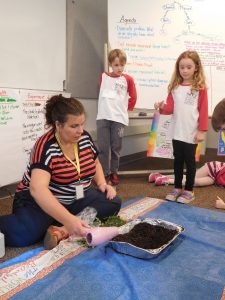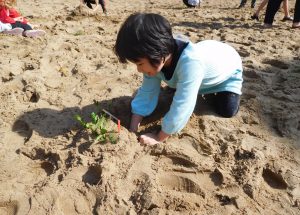Fall SAVY 2016 (Day 4) – Where’s the Beach?
Hello Parents!
For our 4th week of Fall SAVY, students explored the causes and solutions for wind and water erosion. We began by finding out what the students already knew about erosion. They readily recalled the weathering lessons from last week, and discussed how wind and water can wear away rocks. They knew that erosion is a natural process and that it might cause “devastation” and “make the beach system dysfunctional”. Building on their  understanding of weathering, we set up an experiment to test the effects of wind and water erosion on soil. As we gathered in a circle on the floor, we placed a pan of soil in the center. We discussed the differences between sand and soil. Many of the children shared their knowledge of how soil contains organic matter from decomposition.
understanding of weathering, we set up an experiment to test the effects of wind and water erosion on soil. As we gathered in a circle on the floor, we placed a pan of soil in the center. We discussed the differences between sand and soil. Many of the children shared their knowledge of how soil contains organic matter from decomposition.
Students suggested several options for how we could simulate wind, like “fans”, “air conditioners”, “blowing on it” and “using a hair dryer”. We made predictions about what would happen to the soil as the wind hit it. We tested our theories using the hair dryer on various speeds and from different angles. Next, I asked students to suggest ideas for how we could slow down the movement of soil. Several students suggested building fences with craft sticks, or placing plants to help “keep most of the soil in place”, or “anchor it”. After testing our theories, we discovered that indeed, the plants do “stabilize the soil”. We repeated the experiment with water to see how the force of running water moved the soil and how plants helped slow down the erosion.
I’m glad the weather cooperated, because we were able to do our sand erosion experiments outside at the sand volleyball court. We took some building materials, plant clippings, water pitchers, and milkshake straws out with us. Students were asked to build a landscape that included sand dunes. They could use add any of the materials we brought to stabilize their landscape. Next, they used the big straws to simulate wind, and the water pouring over to simulate rain and waves. It was easy to see that the water tended to erode areas in the path of least resistance, away from the dunes and plants, first.
Finally, we looked at systems again and defined how erosion could be seen as a system. We also summarized today’s learning and began a list of possible recommendations to consider for the beach camp problem. I am thrilled so see how the students apply new information to our problem. I’m  also looking forward to next week, when in small groups, they will research specific measures used in attempt to control beach erosion and further develop their recommendations for the camp. Our last session will culminate with a “town council” meeting in which those recommendations are shared and discussed. You can can further today’s learning by asking your child to look for examples of naturally occurring erosion, and for erosion caused by human actions as they walk around their backyard, neighborhood, nearby forest….etc.
also looking forward to next week, when in small groups, they will research specific measures used in attempt to control beach erosion and further develop their recommendations for the camp. Our last session will culminate with a “town council” meeting in which those recommendations are shared and discussed. You can can further today’s learning by asking your child to look for examples of naturally occurring erosion, and for erosion caused by human actions as they walk around their backyard, neighborhood, nearby forest….etc.
Thanks again, and I look forward to seeing the kids next week!
Wendy
Leave a Response